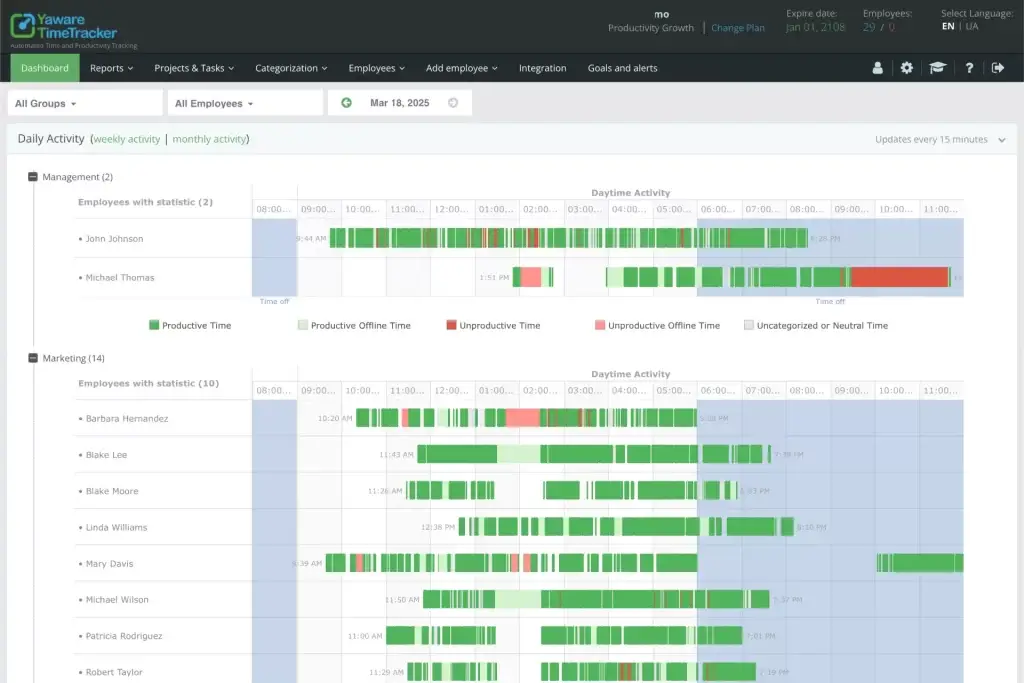Time leaks are the silent productivity killers that subtly drain valuable work hours without anyone noticing. Small inefficiencies such as unnecessary meetings, constant multitasking, or untracked tasks build up over time and create significant losses in productivity and profitability. If left unchecked, time leaks can delay projects, cause missed deadlines, and increase labor costs, all of which chip away at a company’s bottom line.
Time tracking tools are important to plug these leaks. These powerful tools provide accurate and real-time insights so businesses can pinpoint exactly where time is slipping away.
In this article, we will discuss the impact of time leaks on productivity and how time tracking tools can uncover them. We will also tackle how businesses can use these tools to streamline operations, boost accountability, and protect their profitability.
Common Sources of Time Leaks
Time is a valuable resource in business. Time leaks, though seemingly small, accumulate over time and lead to reduced productivity, missed deadlines, and ultimately, increased costs.
The impact on a business can be far-reaching, from project delays to employee burnout and rising labor costs. Some of the biggest contributors to time leaks are habits that destroy productivity. Identifying these time leak sources is the first step in reclaiming lost hours and boosting overall efficiency.
In this section, we will share the common culprits behind time leaks and how they can affect your company’s performance and profitability.
- Too Many Meetings. Excessive or poorly planned meetings can be a significant time leak. Meetings that lack a clear agenda, invite unnecessary attendees, or run off-topic take valuable time away from focused work. This disrupts the flow of productivity and forces employees to spend time regaining their concentration afterward.
- Inefficient Task Switching. Constantly switching between tasks can lead to a productivity drain. Each time an employee shifts focus, they lose time regaining their previous train of thought. This disruption, called the “switching cost,” adds up quickly and leads to longer completion times and decreased overall efficiency.
- Breaks Without Monitoring. While breaks are necessary for maintaining productivity, they can become problematic if not properly monitored. Unscheduled or extended breaks, like random coffee chats or social media scrolling, can quickly derail work hours without the employee realizing the impact.
- Messy or Disorganized Workflows. Disorganized workflows, like unclear processes or misplaced files, can create bottlenecks that slow down progress. Employees waste time searching for information or clarifying tasks. This then increases frustration and can delay project timelines.
- Procrastination That Feels Productive. Procrastination often masquerades as productivity when employees focus on low-priority tasks instead of their main objectives. Spending time over-researching or perfecting small details can give a false sense of accomplishment while important work is left unfinished.
- Time Spent on Irrelevant Tasks. Employees often get sidetracked by tasks that don’t align with business goals. Responding to non-urgent emails or taking on unrelated assignments can become distractions that pull focus from the tasks that truly matter.
How Time Tracking Tools Help Identify Time Leaks

Time tracking tools in modern business operations offer a clear and efficient way to monitor employee productivity and project progress. These tools allow businesses to track the time spent on various tasks while helping to uncover inefficiencies and improve workflow.
As the demand for more effective time management grows, the time tracking software marketsize is projected to expand significantly, from $3.38 billion in 2024 to $11.48 billion by 2032, at a CAGR of 16.5%.
Investing in the best time tracking tools can offer companies the insights to optimize their resources and improve profitability. These tools help businesses streamline processes, identify time leaks, and ensure that every minute spent contributes to overall success.
Here are three ways time tracking tools identify time leaks and the key features that make it possible:
Automatic Time Tracking
Time tracking features like those in Yaware.TimeTracker allow teams to automatically see how much time is spent on tasks — and what’s pulling focus away from getting them done faster.

This helps employees stay on track automatically and feel less stressed, knowing they can reach task faster without distractions.
Especially in flexible or remote work environments, having clear, non-intrusive visibility into daily activity supports both productivity and job satisfaction in flexible work — without the pressure of constant check-ins.
Tracking Time by Project or Task
Time tracking solutions can assign tracked hours to specific tasks or projects. This feature highlights where time is going. It reveals if certain activities are taking too long or diverting focus from priorities. This is useful for reallocating resources and tightening workflows.
Capturing Screens and Webcam
When enabled, capturing screens and webcams helps monitor how much time is spent during work sessions. This visual tracking feature helps verify how logged time is used. Screenshots or webcam images can expose distractions, especially since 95% of workers admit to personal social media use during work hours. While it should be used ethically, this functionality offers a way to address time theft transparently.
How to Use Time Tracking Insights to Optimize Productivity
Time tracking insights help businesses spot inefficiencies, improve workflows, and boost productivity. By analyzing how time is spent, managers can make smarter decisions, cut time leaks, and focus teams on high-impact tasks.
Here are some top tips to make the most of time tracking tools’ insights and create a more organized, productive work environment:
Identify Time Wasters
Time tracking insights reveal when employees are most focused and when productivity dips. This data helps businesses align work schedules with peak performance periods and minimize unproductive activities.
- If a team is most focused between 9 AM and 11 AM, schedule deep work during those hours.
- If time logs show frequent context switching or long idle times after meetings, restructure meeting durations or frequency.
Set Clear Benchmarks and Role-Based Goals
Time tracking insights help set realistic and data-driven benchmarks. Businesses can create clear and achievable goals for each role by analyzing historical time data.
- If a sales team spends 10 hours/week on lead generation, aim to reduce it by 15% for better efficiency.
- Use past project durations to set realistic deadlines and avoid burnout.
Use Role-Specific Insights for Better Accountability
Time tracking tools highlight how employees spend their time based on their roles. This helps enforce accountability.
- A developer should spend more time coding than attending meetings.
- A project manager may focus more on planning and coordination.
Fix Unproductive Time with Better Schedules and Focus
Optimize work schedules by using insights from time tracking tools to uncover low-value activities and distractions.
- If employees lose time to frequent meetings, try fewer or shorter sessions.
- Block off “focus hours” to encourage deep work during peak productivity times.
Use Tools and Charts to Improve Workflow and Visibility
Visual dashboards and charts make it easier to spot inefficiencies and track performance trends.
- If a chart shows one task consistently delays projects, reassign or streamline it.
- Monitor task distribution to balance workloads across the team.
Enhance Performance and Revenue Using Time Tracking Tools
Unnoticed time leaks can severely impact business efficiency and profitability, leading to wasted hours and resources. By tracking activities, categorizing tasks, and offering real-time data, businesses can uncover hidden leaks, optimize workflows, and boost performance. Invest in the right time tracking solution so your company can plug these leaks, reclaim lost time, and ultimately increase revenue. Use time tracking solutions today to take control of your productivity and improve your bottom line.

